Kurt Kinetic’s Rock ‘n’ Roll attempts to inject some of the realism of a road ride to the turbo experience by introducing lateral movement.

The effect is achieved by four elastomer bumpers located between the two mounting plates that attach the A-frame that holds the bike to the stabilizing legs on which the trainer rests. The ‘float’ afforded the A-frame allows the bike to react to pedaling forces by moving from side-to-side, much as it would on the road.
So how does it feel? Remarkably subtle. And that’s its strength. Riders might expect a trainer billed as ‘Rock ‘n’ Roll’ to leave them feeling like a booze cruiser on a cross-channel ferry. The reality is very different. Pedaling in a seated position, the effect is barely noticeable – a good thing. The Rock ‘n’ Roll easily accommodates the minimal lateral movement you would hope to expend while pedaling in the saddle, and even incorporates a little vertical movement.
Sprinting is a different matter. The trainer gives as much lateral movement as you can handle for out-of-the-saddle efforts, swaying left to right in response to energy driven through the pedals and the handlebars. It’s when pedaling out of the saddle – and being made to ‘balance’ – that pedaling on the Rock ‘n’ Roll is at its most realistic. Combined with the Turn Table riser ring (a plastic block with four varying heights that rests on a swivel plate below the front wheel), you’re forced to concentrate on remaining upright. This is a mental trick, of course (not even I can fall off a static trainer) [Oh yes you can – ed.] but one which adds a welcome note of interest to the watching-paint-dry tedium of turbo training.
Much play is made in the marketing blurb of its ability to engage core muscles, but, frankly, the Rock ‘n’ Roll isn’t going to turn you into Bruce Lee, any more than road cycling will. Certainly, it demands more of the upper body than a conventional, static trainer, but to consider it a replacement for a core workout is optimistic.
Resistance comes from a chamber of heat resistant silicone fluid (it retains its viscosity throughout the ride) that holds an impeller attached to the roller. While the resistance unit contains magnetic parts (two plastic discs, each lined with six ‘neodymium rare earth’ magnets) their function is to unite two halves of a ‘virtual drive shaft’, spinning an impeller inside the fluid chamber, rather than to provide a source of resistance, as on traditional magnetic trainers; likewise the 80-odd fins on the exterior of the fluid chamber’s static aluminum housing exist only to cool the unit, rather than to provide wind resistance.

Pedaling on the Rock ‘n’ Roll trainer is remarkably smooth, and resistance is consistent with effort i.e. out-of-the saddle sprints in higher gears generate a greater resistance than seated spinning, as they would on the road. Kurt say this is due to careful calibration, designed to replicate outdoor conditions, where effort increases with cadence and upshifts. They seem to have done their sums correctly, factoring in to the trainer’s performance the absence of wind resistance.
Attaching the bike to the trainer is a piece of cake. Two threaded locators extend from either side of the trainer, allowing you to position the bike centrally, with a locking ring on each side to retain the position for future rides. A u-shaped quick release clamp snaps the right-sided locator into place, securing the bike. The sizeable footprint (120cm wide by 60cm deep) means you’ll need a fair bit of space to use it. Storage is easy thanks to the detachable supporting legs. Another attractive feature is the ‘coast down’ facility, in which the precision-machined roller spins for about 20 seconds after you’ve stopped pedaling.
Would we recommend the Kurt Kinetic Rock ‘n’ Roll trainer? Yes. But don’t expect a transformative experience. This side-to-side motion is more evolution than revolution. While a welcome step forwards from purely static trainers, the Rock ‘n’ Roll is only a variation on theme of cycling on the spot, a necessary but never-that-enjoyable aspect of winter training when the weather conditions make pedaling outdoors as attractive as showering with your clothes on.
Many thanks to Ride for the use of the trainer and the pictures.


